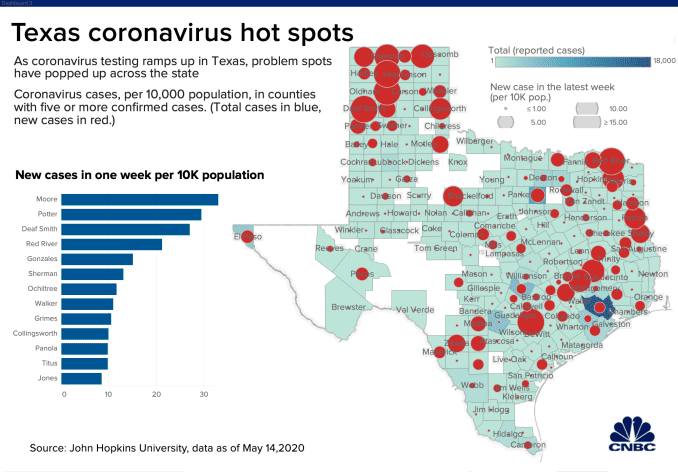Search Results
COVID-19 alert
Common questions
For informational purposes only. Consult your local medical authority for health advice.
KEY POINTS
- Texas started to reopen its economy on May 1, and plans more steps to lift restrictions in the coming days even as coronavirus cases steadily rise.
- Texas’ economy got hit by a range of factors in the spring, including falling oil prices and damage to airlines.
- It could take until next month to understand how the Texas reopening affected the spread of Covid-19 in the state.

Men receive haircuts as social distancing guidelines to curb the spread of the coronavirus disease (COVID-19) are relaxed at Doug’s Barber Shop in Houston, Texas, May 8, 2020.
Callaghan O’Hare | Reuters
Coronavirus cases are rising in Texas as the state plans more steps to restart its devastated economy during the pandemic.
After new reported cases rose by about 1,000 per day in mid-April, they started to climb in May, reaching a new single-day high of about 1,450 on Thursday. While Texans moved more freely around the state after it allowed stores and restaurants to reopen on May 1 with capacity restrictions, the figures could reflect improving testing capacity.
Cases are “definitely increasing but it’s not to the point where it’s overwhelming our health care system,” said Dr. Brian Reed, professor and chair of the department of clinical sciences at the University of Houston College of Medicine.
When Texas partially rebooted its economy at the start of the month, it became the most populous state to do so up to that point. Along with the other largely Republican-led states that lifted restrictions designed to slow the pandemic in late April and early May, Texas looked to buoy a state economy wrecked after most businesses closed their doors.
Texas will next allow businesses such as gyms to open on Monday with capacity limits.
The decision comes with immense risk. Experts say more freedom of movement leads to expectations of increased infections — though people’s decisions to continue distancing and wear face coverings in public could limit the spread. This week, National Institute of Allergy and Infectious Diseases Director Dr. Anthony Fauci warned Congress that states could see “little spikes that might turn into outbreaks” if they restart their economies too soon.
In Texas, roughly 1.8 million people have filed for jobless benefits in the last seven weeks. That comes out to 9.2% of workers covered by the state’s unemployment program.
A combination of issues hit the Texas economy in the spring, said Robert Dye, senior vice president and chief economist at Comerica Bank. While the pandemic takes its toll, U.S. benchmark WTI crude oil futures have fallen more than 50% this year — a blow to the American energy capital of Texas. The state also houses the headquarters of American Airlines and Southwest Airlines, two companies damaged by travel reductions, and has seen cross-border commerce with Mexico drop.
Dye expects a “significant decline” in Texas GDP in the second quarter. He also said that if coronavirus cases spike later this year, he would expect a “major pullback in the economy” immediately. Dye added that the effects could manifest long-term in businesses reluctant to bring on staff as they worry about repeated shutdowns leading to a cycle of hiring and firing.
It could take until next month to know how reopening affects the number of new cases in Texas. It can also take 10 days for hospitalization numbers to catch up with infection figures, and three-to-four weeks for data on deaths to do so, according to Lauren Ancel Meyers, director of the University of Texas at Austin Covid-19 modeling consortium.
She said tracking data show movement to places such as grocery stores has increased in recent weeks, though it is difficult to predict how much people are taking steps such as distancing and wearing face coverings.
“Right now it’s hard to know the extent to which people are going out and taking those kinds of precautions,” Meyers said.
While total cases in Texas are highest in cities, rural Texas has taken a bigger hit on a per-capita basis, particularly in the northern and eastern parts of the state. Reported cases in Texas now exceed 43,000.









No comments:
Post a Comment